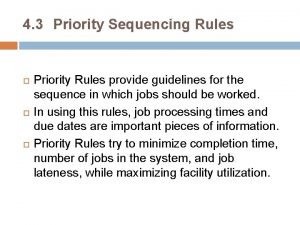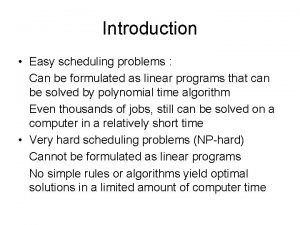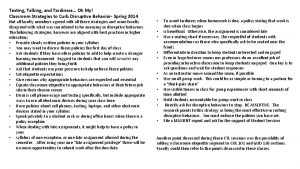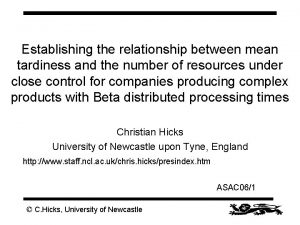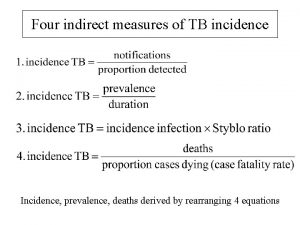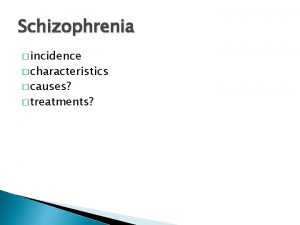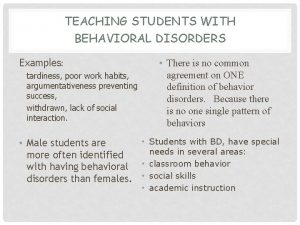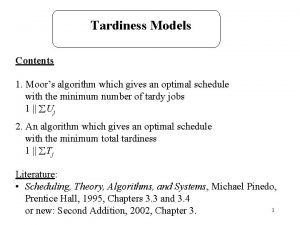Tardiness in Early Education Incidence Predictors and Consequences


























- Slides: 26

Tardiness in Early Education: Incidence, Predictors, and Consequences (Spring 2011) Mariajosé Romero, Ph. D

Overview o Little research on student tardiness in schools o Early Childhood Longitudinal Study, Kindergarten Cohort, provides data on late school arrivals among children who entered Kindergarten in 1998

In Kindergarten, half of the children were late to school at least once o o Children were tardy 3. 5% of the school year (or six days) Tardiness ranged between less than 1% (or one day) and 60% (or 108 days)

Children were more often tardy in Kindergarten if they were o o o Hispanic or Black Enrolled in full-day programs Repeating kindergarten

Children were more often tardy in Kindergarten if they o Received Head Start or non-relative care in the year prior to K

Children who were more often tardy in Kindergarten o Were described by teachers at the beginning of K as having socio-emotional difficulties

Other things being equal, the odds of being chronically late in K were o 3. 5 times higher is children were Black, when compared to white children o Almost double if children were Hispanic, when compared to white children o 40% less if they attended a morning program compared to a full day program o 50% less if they attended an afternoon program compared to a full day program

Poor and low income children were more often tardy in K o Than their middle and upper income peers

Tardiness was related to other maternal and family characteristics, o Particularly risk exposure

Other things being equal, the odds of being chronically late were o Tripled if mothers were Black versus white o Doubled if mothers were Hispanic versus white o More than doubled (x 2. 3) if mothers were single parents o Almost tripled if mothers had become parents as teenagers

Being chronically tardy (>=10%) in Kindergarten increased the odds of being chronically absent o o x 10 chances of being a chronic absentee (>=10%) in K x 10 chances of being a chronic absentee (>=10%) in 1 st Gr. x 3 chances of being a chronic absentee (>=10%) in 3 rd Gr. x 3 chances of being chronically absent (>=10%) in 5 th Gr.

Children who were chronically tardy in K had poor academic performance

What do we know from research in preschools? o As part of the Perfectly Punctual Campaign, Learning & Leadership in Families, Inc. , has embarked on efforts to collect data o Site survey of n Attendance and absenteeism n Professionals’ perspectives n Parents’ perspectives o National Survey of HS professionals

How easy is it to gather attendance and tardiness data in HS programs? Attendance and tardiness data are collected everyday by staff in all HS programs but not stored in ways that are easy to use Substantial mobility across programs => to collect accurate data, it is important to understand when children: o o n n n n n Join the program Leave the program Are disenrolled because of excessive absence Sites may have classes that offer different types of programs: part-day in the morning part-day in the afternoon full-day with early drop-off or late-pick up services To collect accurate data, it is important to know clearly when children are supposed to arrive and leave, and when they actually do

Absenteeism and tardiness seem to be rather common in HS programs o Different groups of children emerge depending on whether and how often they are absent and tardy

Professionals in one site believe that tardiness is

Nationally, the majority of HS professionals report that 3 -6 children in their groups are late every week Source: LLF / NHSA survey, March 2009

HS professionals agree that punctuality o Creates a positive parent-teacher relationship o Helps children do better in school o Is one way parents can support learning o Helps young children develop friendships o Is one way parents and teachers can work together

But HS professionals seem to be more permissive towards lateness o One-quarter to one-third of professionals surveyed feel neutrals towards or disagree with the claim that lateness

To have or not to have a punctuality policy? o Staff in centers that have an articulated punctuality policy more often believe that believe n n The Center Director can shape children’s attitudes about punctuality Neighborhood values can potentially shape children’s attitudes about punctuality o What seems to make a difference is not whether centers have a punctuality policy, but whether or not they use it consistently n Staff report less punctuality problems in centers where the policy is consistently invoked

Professionals see parents as the primary influence on young child’s punctuality Source: LLF / NHSA survey, March 2009

Professionals disagree on whether parents understand the punctuality policy o But 90% parents claim that they understand it

Parents are divided on whether punctuality at their child’s program is

Parent attitudes: Punctuality versus Lateness Source: LLF / Morgan State University Head Start survey, May 2010

In conclusion, tardiness… o May begin, along with absenteeism, well before children enter formal schooling o Has serious consequences for early learning and development o Affects the most vulnerable children o Elicits different perspectives and practices among professionals and parents o These perspectives and practices need to be reconciled to provide a sustained and consistent, high quality early education program

For questions Current contact information for Dr. Romero Director of Assessment and Planning Dyson College of Arts and Sciences 914. 773. 3956 mromero@pace. edu
 Tardiness in education
Tardiness in education Incidence density formula
Incidence density formula Epirates
Epirates Roc curve with multiple predictors
Roc curve with multiple predictors Job lateness formula
Job lateness formula Apparent tardiness cost
Apparent tardiness cost Early cpr and early defibrillation can: *
Early cpr and early defibrillation can: * Difference between descriptive and analytical epidemiology
Difference between descriptive and analytical epidemiology Incidence geometry proofs
Incidence geometry proofs Owasp cloud top 10
Owasp cloud top 10 Ecetp trainings
Ecetp trainings Acecqa self assessment tool
Acecqa self assessment tool Isaac newton early childhood
Isaac newton early childhood California workforce registry
California workforce registry Workforce registry ca
Workforce registry ca Setting of things fall apart
Setting of things fall apart Objective consequences
Objective consequences Nikki giovanni choices
Nikki giovanni choices What is sin and its consequences
What is sin and its consequences Hazardous attitudes
Hazardous attitudes What is the relationship between choices and consequences
What is the relationship between choices and consequences Actions and their consequences examples
Actions and their consequences examples Romeo and juliet act 4 scene 2 questions
Romeo and juliet act 4 scene 2 questions Rising food prices causes and consequences
Rising food prices causes and consequences Actions and their consequences examples
Actions and their consequences examples Intrinsic rewards are psychic and self granted
Intrinsic rewards are psychic and self granted Perpendicular incidence
Perpendicular incidence




